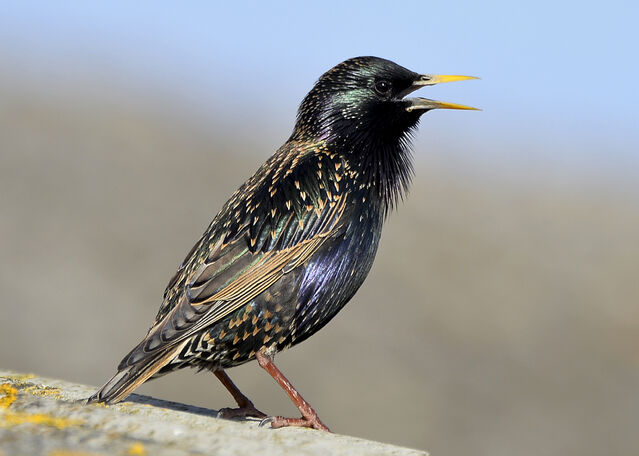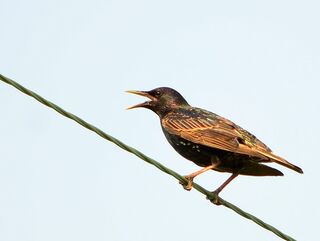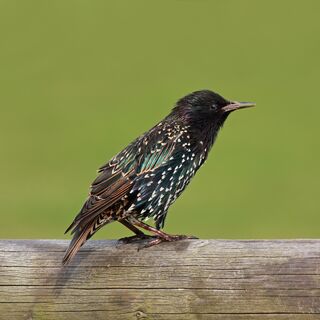Play
Does Singing Give Birds a Natural High?
New research shows links between singing, reward, and endogenous opioids.
Posted July 24, 2020 Reviewed by Devon Frye

Songbirds seem to enjoy singing. And while a great deal of research has investigated the development and production of birdsong, little is known about the motivation to sing.
New work out of Lauren Riters’ lab at the University of Wisconsin-Madison teases out the relationship between singing, reward, and endogenous opioids in songbirds. The results suggest that studying songbirds can teach us about the shared neurobiological mechanisms underlying social reward in all vertebrates, humans included.
A Song in Their Heart
Male songbirds are renowned for the songs they produce to attract mates and defend territories, but birds sing in other contexts, too. Outside of the mating season, male and female starlings form large flocks in which both sexes sing at high rates. These "gregarious songs" are not directed toward other birds and have no obvious function. Indeed, Charles Darwin proposed that birds sing “for their own amusement” after the mating season ends.
Riters can see how Darwin would come to that conclusion.
“When I listen to these birds sing, it seems as if they are enjoying themselves,” she says. “To me, it sounds like free-form jazz riffs. And we’ve shown that the non-breeding songs are quite distinct from the more structured songs that males produce in more serious reproductive contexts.”
So how do you ask a bird if it feels good to sing? One way is the conditioned place preference test, a classic psychological method that Riters has adapted for use in birds. Previous work from her lab has shown that songbirds choose to spend more time in a place that they associate with gregarious song. This suggests that singing is a positive experience for the bird.
Riters’ lab has also gathered evidence that endogenous opioids—substances produced by the body that act to induce pleasure and reduce pain—may be involved in gregarious song. In animals from birds to humans, endogenous opioids play a central role in naturally occurring rewarding behaviors, such as social play, sex, and eating.
While previous research suggested that gregarious singing, reward state, and opioids are related, no one had demonstrated a causal relationship between birdsong and opioids—until now.
Flocking Together, Singing Together
In the first part of the new study, Riters and her colleagues treated starlings with low doses of fentanyl, a drug that stimulates the opioid receptors best known to induce reward. Then they observed how the birds behaved in flocks in outdoor aviaries.
The researchers found that fentanyl triggered high rates of gregarious song while also reducing stress-related behaviors.

In the second experiment, Riters and her colleagues downregulated the receptor that fentanyl stimulates in a brain region that is involved in both song and reward (the medial preoptic nucleus). The idea was to break the link between singing and reward by manipulating the endogenous opioid system.
This resulted in reduced gregarious singing when birds were in flocks. Additionally, the birds did not develop a preference for a place that had been paired with song.
Together, the results suggest that the presence of flock mates or the safety of a flock may naturally lead to opioid release and induce a positive, low-anxiety state that is conducive to gregarious singing. This study also provides evidence that singing itself triggers the release of endogenous opioids.
Social Animals
Riters says it’s not likely that these results are just a "bird thing": They may generalize to other species and other social behaviors. That’s because the neural mechanisms that regulate social behaviors tend to be highly similar across vertebrates.
“If this is the case, it would mean that our studies on songbirds are revealing an ancient, evolutionarily conserved neural circuit that regulates intrinsically rewarded social behaviors across many animals,” says Riters.
One mammalian behavior that shares core features with gregarious birdsong is social play. Like gregarious song, social play is a spontaneous, affiliative behavior that is important for developing social skills.

Riters and her team have begun exploring the role of endogenous opioids in the social play of rats. Thus far, they have found that opioid receptors in the same brain area they studied in songbirds (the medial preoptic nucleus) also regulate social play behavior in rats. This suggests that from studies of these neural circuits in songbirds we may learn about mechanisms underlying social reward that extend across vertebrates—including humans.
“Because the brain circuits and neurochemicals that control social behavior in birds and mammals are similar, studying rewarding birdsong can help us understand how the brain makes social behaviors positive and rewarding in humans, as well,” says Riters.
In other words, this research could potentially influence the development of new treatments that can promote positive interactions in people that may be socially withdrawn or no longer find human contact to be rewarding (for instance, in cases of depression or social anxiety).
Riters’ lab is continuing to use studies of birdsong and rat play to identify the core neural circuits that make positive social behaviors rewarding, with an eye toward exploring the role of these circuits in humans. Riters is finding special relevance in this work in the current moment, amid recommendations to socially distance to curtail the spread of the novel coronavirus.
“Our starling studies suggest that during this time of social distancing, without the contact of our ‘flock mates,’ we are essentially deprived of the pain-reducing and pleasure-enhancing effects of endogenous opioid release,” she says.
It’s another reminder that we are social animals who depend on connecting with others in our flock for our well-being.
References
Stevenson, S.A., Piepenburg, A., Spool, J.A., Angyal, C.S., Hahn, A. H., Zhao, C., and Riters, L.V. Endogenous opioids facilitate intrinsically-rewarded birdsong. Sci Rep 10, 11083 (2020). DOI: 10.1038/s41598-020-67684-1.




